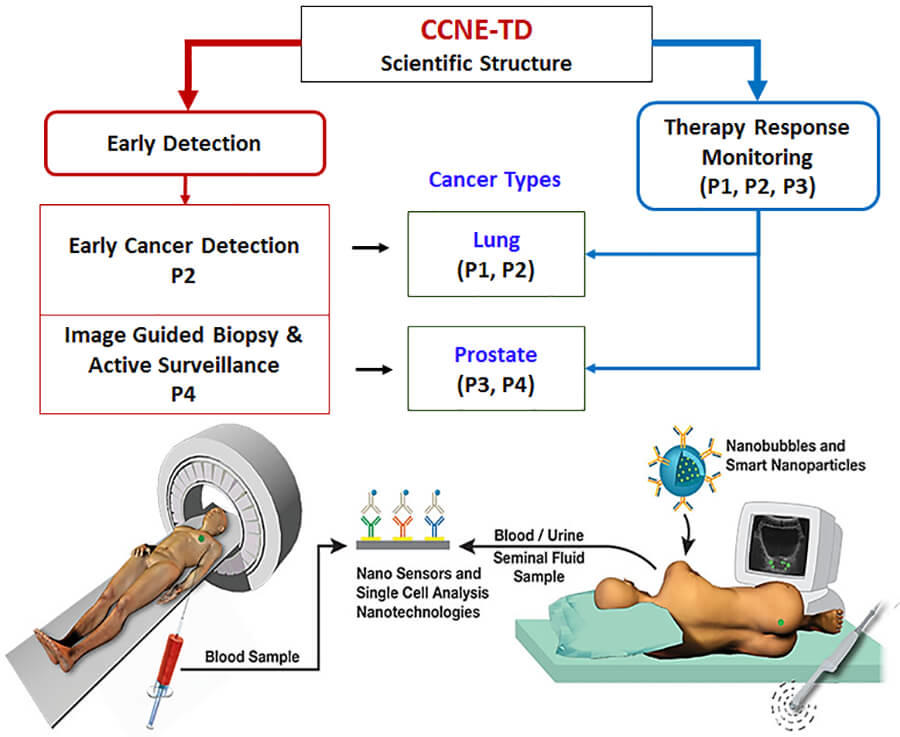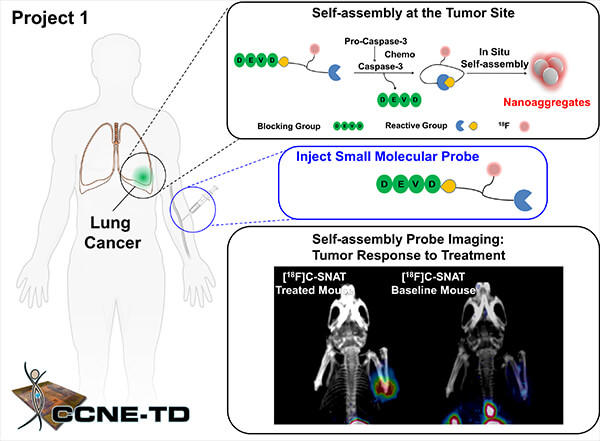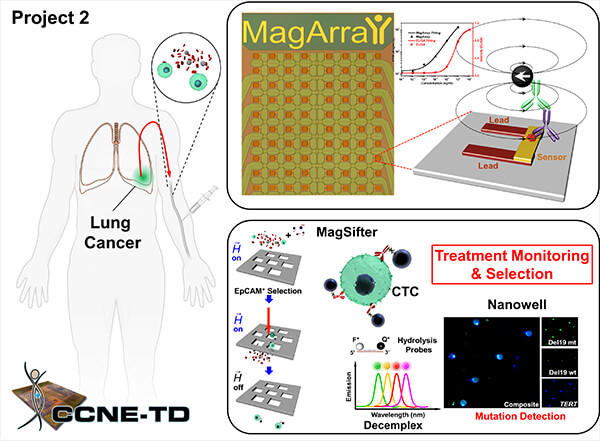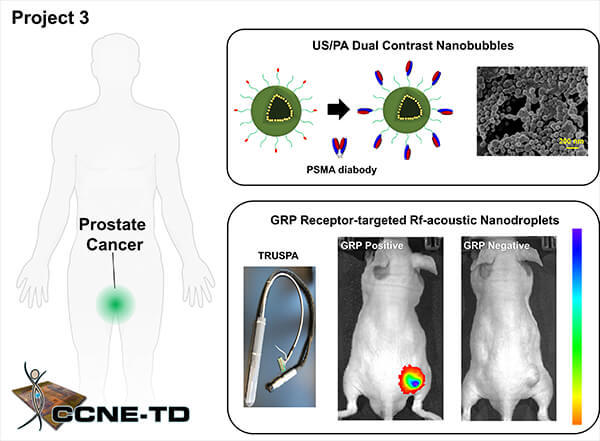Stanford University — Center of Cancer Nanotechnology Excellence for Translational Diagnostics (CCNE-TD)
Center Overview
The CCNE-TD, which forms the third cycle CCNE Program at Stanford University, is a consortium that has three highly synchronized Projects and three Cores. Since its initial funding in May 2006, the Stanford CCNE program has matured substantially into a strong multidisciplinary program with expertise and infrastructure to support the growing field of cancer nanomedicine. PI Sanjiv Sam Gambhir, M.D., Ph.D. is the Chairman of the Department of Radiology at Stanford and an expert in Molecular Imaging, Radiology and Bioengineering. MPI Shan X. Wang, Ph.D., is a Professor of Materials Science and Engineering as well as Electrical engineering at Stanford. He has spent the major portion of his career focused on magneto nanobio-sensing. Deputy Director Demir Akin, D.V.M., Ph.D., is an interdisciplinary scientist and a well-known nanomedicine expert. Together, Drs. Gambhir, Wang and Akin provide an enormous breadth of experience ranging from fundamental nanoscience and engineering, to pre-clinical imaging, and on to translation of molecular imaging and cancer nanodiagnostics for clinical applications. The Center is composed of a highly interdisciplinary team of scientists whose expertise areas are highly synergistic and have a long collaboration history that extends to the first cycle of the NCI's CCNE Program.
The CCNE-TD will develop and clinically translate cancer diagnostics and imaging technologies in two scientific thematic focus areas: i) predicting and monitoring cancer therapy response in lung cancer and ii) merging nano-based in vitro and in vivo diagnostics strategies and nano-based imaging for earlier cancer detection and prognostication of prostate cancer. CCNE-TD investigators will utilize nanotechnology to measure changes in cancer patterns via 1) imaging though cancer-triggered-self-assembling as well as dis-assembling nanoparticles (Projects 1 and 3) and 2) in serum using magneto-nano sensors (Project 2). Center nanotechnologies will be used to interrogate single cells for DNA, RNA, proteins, cellular micro/nano vesicles, to evaluate biomarker potentials of those (Projects 2 and 3), and will again utilize nanotechnology (e.g., self-assembling nanoparticles and nanobubbles) to image cell associated proteins in small animal models, as well as humans, and clinically translate them for human prostate cancer imaging with ultrasound / photoacoustics (Project 3). In all of these cases, changes at the molecular level are being measured within the cell, on the cell membrane, and in the extracellular matrix. We believe that measuring these changes is critical to the problem of earlier cancer detection and monitoring response to therapies with both the ex vivo diagnostic nanosensor technologies and the in vivo imaging technologies.
The Center has two major technological arms: i) in vitro genomic/proteomic/cellomic nanosensors, and ii) in vivo molecular imaging with primarily gold as well as nanobubble-based nanoparticles, and magnetic resonance imaging (MRI) with novel self-assembling and disassembling nanoparticles. The latter arm is directly focused on molecular imaging with specific cellular protein targets. These targets are the basis whereby specific molecular imaging signal is provided. It is the goal of the CCNE-TD to help identify these targets for specific cancers (lung and prostate) and their biochemical pathways and to utilize these targets as ways to home in on cancer cells. In addition, our new class of nanoparticles that can self-assemble intracellularly, from the cell permeable precursors, in a cancer specific manner, in conjunction with our advanced magnetic resonance imaging (MRI) expertise, is expected to directly impact the development of medical imaging modalities for eventual clinical translation. With our highly interactive and cohesive program focused on developing and validating nanotechnology for anti-cancer therapy response, earlier cancer detection and prognostication, we will imagine, invent, and innovate for the benefit of cancer patients.
Projects
Project 1: Multimodality Self-Assembling and Disassembling Nanoparticles
Project Investigator: Jianghong Rao , Ph.D.
Led by Jianghong Rao, an Associate Professor of Radiology and Chemistry, this project focuses on the development of novel, cancer-triggered self-assembling and disassembling nanoparticles for photoacoustic and PET-MRI visualization of tumors.
Project 2: Multiscale Nanotechnologies for Comprehensive Assessment of Lung Cancer in Blood
Project Investigator: Shan Wang, Ph.D.
Project 2, led by Center PI Shan Wang, focuses on the use of magneto-nanotechnology for blood proteomics, single cell sorting and comprehensive analyses.
Project 3: Multimodality Molecular Nanoimaging of Cancer
Project Investigator: Sam Gambhir, M.D., Ph.D.
Project 3, led by Center PI Sam Gambhir, will pursue molecular imaging of prostate cancer through photoacoustic imaging with smart nanoparticles made by Project 1. The project will also develop strategies for monitoring response to anti-lung cancer therapy using imaging and magneto-nanosensors.
Cores
NanoCharacterization and NanoFabrication Core
Core Investigator: Robert Sinclair, Ph.D.
The NanoCharacterization and NanoFabrication Core is led by Robert Sinclair. The Nano Characterization and Nano Fabrication research core will provided advanced characterization and synthesis support for the projects within the CCNE-TD. The core consists of the Stanford Nano Shared Facilities (SNSF) which is comprised of the Stanford Nanocharacterization Laboratory (SNL) and the Stanford Nano Center (SNC) offering resources for the analysis and fabrication of nanostructures and their interactions with biological materials.
Clinical Translation Core
Core Investigator: Alice Fan, M.D., Ph.D.
The Clinical Translation Core is led by Alice Fan. This core facilitates clinical translation by linking Center nanotechnologies to existing patient samples and ongoing as well as new clinical trials.
Developmental Program
Center Program Director: Sam Gambhir, M.D., Ph.D.
The Center has set aside funds for developing Pilot Projects to extend Center capabilities over the five year performance period. Center leadership have also raised substantial funds internally at Stanford to run additional seed / developmental projects. These internally sponsored projects with focus on clinical translation will be at no-cost to NIH-NCI.



